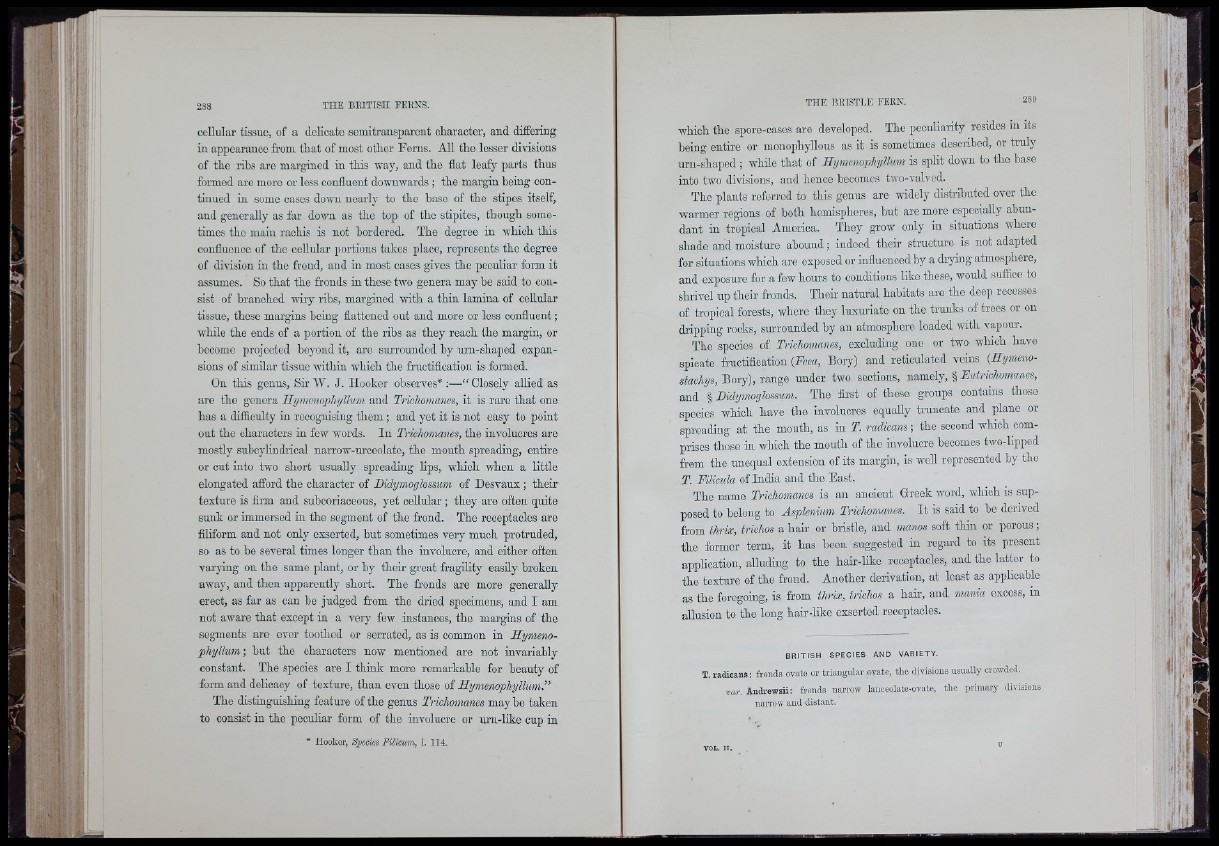
if
m
cellular tissue, of a delicate semitransparent character, and differing
in appearance from that of most other Ferns. All the lesser divisions
of the ribs aro margined in this way, and the flat leafy parts thus
formed arc moro or less confluent downwards ; tho margin being continued
in seme cases down nearly to the base of the stipes itself,
and generally as far down as tho top of the stipites, though sometimes
the main raohis is not bordered. The degree in which this
confluence of the ooUular portions takes place, represents the degree
of division in the frond, aud in most oases gives the peculiar form it
assumes. So that the fronds in these two genera may be said to consist
of branched wdiy ribs, margined with a thin lamina of cellular
tissue, these margins hoing flattened out and more or less confluent;
while the ends of a portion of the ribs as they reach the margin, or
become projected beyond it, arc surrounded by urn-shaped expansions
of similar tissue within which the fructification is formed.
On this genus. Sir W. J. Hooker observes* ;—“ Closely allied as
are the genera IlymenoplnjUum and Trichomanes, it is rare that one
has a difficulty in recognising them ; and yet it is not easy to point
out the characters in few words. In Trichomanes, the involucres are
mostly suboylindrical narrow-urceolato, the mouth spreading, entire
or cut into two short usually spreading Kps, which when a little
elongated afford tho character of Bidymoglossmn of Desvaux ; their
texture is firm and subcoriaceous, yet cellular; they are often quite
sunk or immersed in the segment of the frond. The receptacles are
filiform and not only exserted, but sometimes very much protruded,
so as to he several times longer than tho involucre, and either often
varying on the same plant, or by their great fragfiity easily broken
away, and then apparently short. The fronds are more generaUy
erect, as far as can be judged from the dried specimens, and I am
not aware that except in a very few instances, the margins of the
segments are ever toothed or serrated, as is common in Hymeno-
phyllim-, but the characters now mentioned are not invariably
constant. The species are I think more remarkable for beauty of
form and deUcacy of texture, than even those of IlymenophyUum.”
The distinguishing feature of the genus Trichomanes may be taken
to consist in the peouKar form of the involucre or urn-Uke cup in
* Hooker, Species F ilk um , i. 114.
which the spore-cases are developed. The peculiarity resides in its
heing entire or monophyllous as it is sometimes described, or truly
urn-shaped; whilo that of Hymenophyllum is split down to the base
into two divisions, and hence becomes two-valvcd.
Tho plants referred to this genus are widely distributed over the
warmer regions of both hemispheres, but are more especially abundant
in tropical America. They grow only in situations whore
shade and moisture abound; indeed thoir structure is not adapted
for situations which are exposed or influenced by a drying atmosphere,
and exposure for a few hours to conditions like these, would suffice to
shrivel up their fronds. Their natural habitats are the deep recesses
of tropical forests, where they luxuriate on the trunks of trees or on
dripping rocks, surrounded by an atmosphere loaded with vapour.
The species of Trichomanes, excluding ono or two which have
spicate frnotification {Feea, Bory) and reticulated veins {Hymeno-
stachys, Bory), range under two sections, namely, § Eutrichomanes,
and § Bidymoglossum. The first of these groups contains those
species which have the involucres equaUy truncate and plane or
spreading at the mouth, as in I . radicans; the second which comprises
those in which the mouth of tho involucre becomes two-lipped
from the unequal extension of its margin, is weU represented by tho
I . Filicula of India and the East.
The name Trichomanes is an ancient Greek word, which is supposed
to belong to Asplenium Trichomanes. It is said to be derived
from thrix, trichos a hair or bristle, and manos soft thin or porous;
the former term, it has been suggested in regard to its present
application, aUuding to the hair-Uke receptacles, and the latter to
the texture of the frond. Another derivation, at least as applicable
as the foregoing, is from thrix, trichos a hair, and mania excess, in
aUusion to the long hair-like exserted receptacles.
BRITISH SPECIES AND VARIETY.
T. radicans; fronds ovate or triangula r ovate, tk e divisions usually crowded.
var. Andrewsn; fronds narrow lanceolate-ovate, tk e primary divisions
narrow an d distant.
■ ’!t.
■ri tl
■) ! i-r
■ m
i :I
Iri
II
■'-m
■’*' Ml
:■ '1 ’'J
1